Cellion primax: The New Benchmark in Rechargeable Hearing Aid Technology
Frank Naumann, Dipl. Ing., Beate Kraemer M.A. and Rebecca Herbig, Au.D.
Introduction
For the past decade, Siemens/Signia, has been known as the pioneer and benchmark in terms of energy efficiency and rechargeable hearing solutions (for review, see Filips, 2012). Since the launch of Centra Active and the first eCharger in 2006, Signia has offered a large rechargeable portfolio.
The foremost customer benefit of rechargeable hearing instruments is the increased usability compared to hearing instruments using conventional batteries. In state-of-the art solutions, there is no need for exchanging the batteries or to switch the hearing instrument on/off. Handling is much easier, especially for customers with dexterity issues. Another beneficial feature is the smart-drying function which automatically dries the hearing aid from inside out during charging without the need for additional consumables. Industry-wide surveys show that customers are also very interested in using rechargeable hearing instruments. They want a safe, robust, and reliable rechargeable hearing aids that last for a whole day (MarkeTrak, 2015).
Over the last decade, as hearing aid technology has advanced, its demand on energy as also increased. Recent features such as Bluetooth streaming and binaural audio transmission all draw unprecedented amount of power. It is estimated that hearing aid energy demand increases by approximately 10 percent from platform to platform. Therefore, a reliable, higher capacity power source that does not increase the hearing aid size or require more frequent battery changes is necessary.
Signia’s Cellion primaxTM is the world’s first RIC hearing instrument featuring lithium ion rechargeable batteries, together combined with a new small wireless charger. This innovative hearing system meets patient expectations for battery usability and reliability– today and also in the future. This paper details the patient benefits and the technical advantages of this innovation.
Lithium ion technology is superior for hearing instrument use
Signia’s galvanic rechargeable technology has been successfully in the market for 10 years. However, there has been little advancement with regards to capacity improvements of the NiMH battery. This means that as technology advances, it is becoming more difficult to support a full day of hearing aid use. Therefore, a new rechargeable solution was required. Lithium ion technology provides the ideal technology base. For a comprehensive review of different battery technologies, and their pros and cons, see Heuermann & Herbig (2016). Some of the advantages of the lithium-ion solution include:
- High energy capacity
- High number of recharging cycles
- Numerous competitive suppliers to ensure future advancements and capacity increase
High capacity – down conversion
Lithium ion is a battery chemistry which works at battery voltages between 3.7 to 4.2 Volts. This voltage is much too high for hearing aid use. If applied directly, it would instantly destroy the hearing aid. To make use of the energy, a down-conversion of the battery voltage to the hearing aid level is needed.
There are different technical solutions to realize down conversion. The easiest is a static down conversion, for example, to 1.4 V. This is easy to implement, but has the down side that it is not possible to know the state of charge of the battery. Normal hearing aids calculate the battery status by the decrease of the battery voltage – but if the voltage is always the same, it is not possible to use this feature.
For Signia hearing aids, a special power management integrated circuit (IC) has been developed to avoid this problem. It divides the battery voltage by 3. This means that when the battery has a voltage of 4.2 V, the actual voltage provided to the hearing aid is 1.4V (Figure 1). For the patient, this translates to being able to see the state of charge (full vs. empty) which has not been possible with the former NiMH galvanic charging solution.
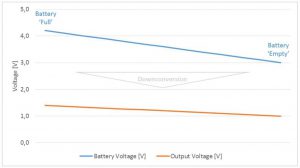
Figure 1. Diagram showing the correlation of the output voltage and the battery voltage using down conversion The capacity a 1.4V output voltage equals 4.2V battery voltage.
Another advantage of this down conversion is the physical law that energy does not get lost. In theory, this means when you convert the voltage down by three, the capacity goes up by factor of three. In practice, this means that there are usually certain (e.g. thermal) losses due to this down conversion which result in a lower down-conversion efficiency. The typical down-conversion efficiency is 80 – 85% which means 15 to 20% of the energy will be lost. The Power Management IC used in Cellion works with an extremely high efficiency of 95%. This means only 5 percent of the energy gets lost.
High capacity – battery capacity and battery size
The capacity of the lithium ion battery used in Cellion has a 17.5mAh at 4.2V. This corresponds to a theoretical capacity of around 51mAh at the down-converted, operative voltage of approx. 1.3V. Given the 5% loss, the final capacity is 50mAh. This means that a Cellion hearing aid with current binaural streaming technology can last for more than 30 hours (see Figure 4).
The battery used in Cellion hearing aids is slightly bigger than a standard 312 battery (see Figure 2). Battery contacts become obsolete, as charging is accomplished inductively, and the battery is no longer exchanged regularly as in conventional hearing aids. This opens space for a 10% bigger battery.
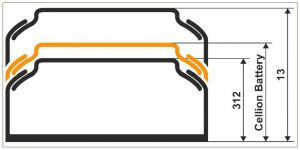
Figure 2. Battery size comparison between conventional hearing aid batteries and Cellion lithium ion battery.
High capacity – energy density
Higher battery capacity means a longer runtime of the hearing aid on a single charge. A comparison of the Cellion lithium ion cell capacity with other battery technologies is difficult due to its special form factor (Heuermann & Herbig, 2016). Therefore, the effective capacity per volume is used for such a comparison. In Figure 3, observe that lithium ion is the battery technology with the highest available capacity in relation to battery volume.
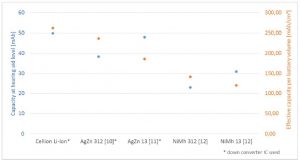
Figure 3. Capacity and energy density of different battery types.
Compared to the conventional 312 NiMH charging solution, the runtime for the lithium-ion is more than doubled (capacity increase from 23mAh to50mAh).
In the most power-draining use case, a Signia Cellion primax hearing aid consumes on average 1,6mA per hour. For our purposes, this use case assumes that the most powerful receiver is used, the hearing aid has a high percentage of low frequency amplification, and binaural streaming features are frequently used (Herbig, 2014). Even under this extreme condition, there is enough power to run the hearing aid for more than a day (Figure 4).
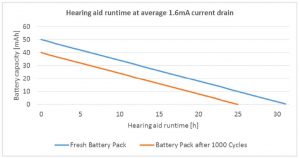
Figure 4. The Lithium ion power cell capacity is sufficient to run Cellion for more than 24 hours even after 1000 cycles.
High number of recharging cycles
The next big advantage of lithium ion is its cycle lifetime. Today’s NiMH batteries last for 300 recharging cycles, AgZn batteries last for 400+ cycles, but lithium ion even outperforms this with an expected lifetime of 1500+ cycles. A lithium ion battery can thus last for 4 to 5 years in a hearing aid, which in some cases, is the full lifetime of the hearing aid itself. Even if the battery module suffers damage, it can be easily exchanged by the hearing care professional (See Figure
5).
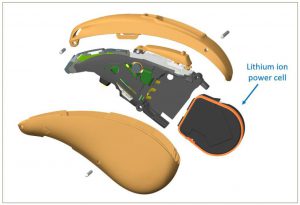
Figure 5: Cellion components.
Future outlook
Lithium ion rechargeable batteries are commonly used in wearables, phones, and entertainment gadgets. As lithium ion is widely used, there will be further technical improvements, whereas for NiMH there were no major performance leaps in the last years. We already now see clear indications that the performance of lithium ion batteries will further improve in the future.
Charging solution designed for ease of use
Inductive charging
A safe and long-lasting lithium-ion power cell is not the only element which makes Cellion the industry benchmark rechargeable hearing aid. Another key attribute which differentiates it from competitors is that it employs inductive, rather than galvanic, charging.
Inductive, or wireless charging, is accomplished via electro-magnetic induction. In the charger, alternating current (AC) causes a varying magnetic field in a dedicated transmitter coil. This magnetic field in turn induces a similarly varying magnetic field in the receiving coil of the device when Cellion is placed close to the charger. The proximity allows energy to be transferred wirelessly from the charger’s coil to the Cellion‘s coil. There, the energy is transformed into alternating current, which is then rectified to direct current (DC) so that it can charge the power cell (Figure 6).
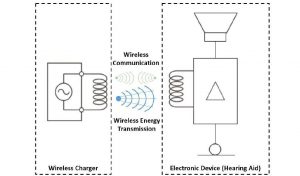
Figure 6. Inductive (also called wireless) charging. Left: The main voltage connected to the charger is converted into high frequency alternating current (AC). The alternating current flowing within the transmitter coil creates a varying magnetic field. Mid: The magnetic field variation extends to the receiver coil if both are placed within a specified distance. Right: The changing magnetic field generates alternating current in the receiver coil of the electronic device. This current is converted into direct current (DC) used to charge the battery.
The key advantage of using inductive charging is that it eliminates charging contacts. The power cell can be completely sealed within the hearing aid; and there are no charging contacts to align during charging. For wearers, inductive charging means:
- Increased ease of use because exact placement of the device in the charger’s cradle is not required.
- No hassling with opening and closing a battery door.
- No electronic contacts that can collect dirt and debris.
- Improved water, sweat, and dust resistance.
- Compliance to all country regulations that do not allow electrodes on the device (e.g., Japan).
User-friendly charger
The versatile Cellion eCharger uses a common micro-USB to USB plug which works with standard USB ports. Compared with similar rechargeable solutions, it is very small and can be easily carried around, eliminating the need for a separate travel charger. The charger is also equipped with LEDs so that the state of charge is easily visible.
The self-drying hearing instrument
Another highlight of the Signia lithium ion wireless charging system is the integrated drying function. Modern IP67 or IP68 rated hearing aids are constructed to prevent sweat or moisture entering the hearing aid casing. Since Cellion has no battery door, one of the key causes for moisture intrusion is eliminated. In the unlikely event that some moisture still enters the aid, the hearing aid employs a smart drying function as the hearing aid warms up during charging. This increase in temperature is used to dry the hearing aid. This has two major advantages. First, the hearing aid dries much faster than any other technology available on the market (Figure 6). Secondly, the drying works without heating up the charger, and without silicate capsules, a product which requires frequent changing and extra expenses. The lithium ion drying function is fast, energy efficient and environmentally friendly. It is considerably more efficient than alternative methods (Figure 7).
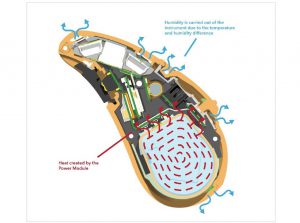
Figure 7: Only the necessary charging components heat up, thus ensuring an efficient and energy conscious drying of the hearing aid.
To avoid overheating during charging, the system includes a special sensor which controls the temperature so that there is no danger of battery damage or decrease of the battery lifetime.
As you can see in Figure 8 for normal drying or drying via silicate capsules in a drying box the humidity inside the hearing is still around 100% after 1.5 hours. In the Cellion hearing aid with smart drying functionality, however, the humidity is down to 58% after the same time, and it is below the ambient humidity of 60% at 25°C. The traditional drying box needs to more than 3.5 hours to achieve the same low humidity.
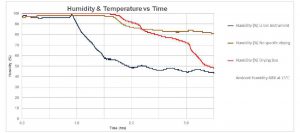
Figure 8. Comparison of different drying processes.
The measurements were done with a specially configured Cellion hearing aid. A humidity sensor was mounted inside the hearing aid which was specially sealed towards the outside. Then a tiny drop (0.02ml) of water was applied to the inner part of the housing. Afterwards the hearing aid housing was mounted and the instrument was placed inside the Cellion Charger, respectively the silicate drying box or left on at table under normal ambient conditions.
Operation time / Charging time
A major concern for hearing aid wearers is the hearing aid batteries “dying’ during use. As mentioned earlier, with the new lithium-ion solution, this is less likely to happen since the hearing aid can run for more than 30 hours on a single charge. Even if the wearer forgets to charge the hearing aids overnight, Cellion is equipped with a special fast-charge function which is realized by a wireless power transmission link.
This fast-charge function is automatically activated when the capacity of the battery is below 40% and the instrument is placed into the charger. In this case, the charge current is doubled and the battery is charged much faster during the first 30 minutes. After these 30 minutes, the charging automatically returns to the normal charging mode, as a slower charge is better for the overall battery lifetime. Table 1 shows that even in a loud acoustic environment and fitted with a power receiver, the hearing aid can operate for up to 7 hours with a 30 minute fast-charge. Even when the easyTekTM streaming accessory is used continuously for TV Audio streaming or telephone communication, the capacity still lasts for more than 6 hours after a 30 min fast-charge. This generally provides enough run time until the next opportunity for a recharge.

Table 1: Cellion run time after short discharges
Shelf life and storage
You probably already know this from your purchase of a smartphone or other rechargeable device: when you unpack the device, the first thing you read is “charge before first use”. We also recommend to charge Cellion before the first usage. To assure a long shelf life of up to 15 months, the hearing aid is put into a “deep sleep mode” in the last production step.
If a user stores away Cellion without switching it off first, the power cell goes into a sleep mode which avoids deep discharge for the next 6 months. After 6 months, the power cell can no longer be charged because of safety concerns. In this case, the old power cell can be exchanged for a new one.
Patients prefer discreet hearing aids, so keeping them small is a must. To support the lithium ion battery technology and wireless, or inductive, charging inside the hearing aids, a highly integrated ultra-efficient Power Management IC (PM-IC) is used to minimize its size. The PM-IC carries 5 major functions:
1. Wireless energy transmission
2. Wireless communication
3. Battery charge controller
4. Battery protection circuits
5. Voltage down conversion
The power cell and the silicon sealing are additonally nanocoated in order to make the device as robust as possible.
Communication between charger and power module
There is a bi-directional communication between the charger and power cell. The bi-directional link has two major functions. It displays the battery charging status on the charger via the integrated LEDs. The second function relates to safety. All charging parameters are permanently monitored by the Power Module PM-IC and the Charging PM-IC. This means if any charging error is detected, charging is stopped and the inductive charging field of the charger is terminated.
Benefit over other rechargeable solutions
Cellion has several advantages over other existing rechargeable hearing aid solutions which directly translates to wearer benefit. First of all, the lithium-ion power cell is completely enclosed in the hearing aid, and never requires replacement by the wearer. As a result, the risk of children or pets accidentally swallowing hearing aid batteries are minimized. (Please note Cellion is not intended to be worn by small children). Some have argued that lithium-ion batteries
are even more harmful than zinc air or silver zinc batteries if ingested (Freeman, Ortega, Dueber, 2016). However, the fact that lithium-ion power cell is sealed and integrated within Cellion means that the child or pet would have to ingest the entire hearing aid completely. Even if that is the case, the hearing aid serves to protect the power cell coming into contact with internal tissues. Cellion power cells are extensively tested and complies with US UL1642, the standard for Li-Ion Battery Safety. This is a decisive benefit over other rechargeable systems where the battery still requires removal for charging.
Cellion is arguably the easiest rechargeable hearing to use. Inductive charging eliminates the need for aligning charging contacts and minimizes charging contacts. Furthermore, once in the charger, Cellion automatically powers off, and automatically powers back on when removed from the charger. The simultaneous de-humidifying function with works without additional drying crystals is another advantage over competitors.
Signia has outstanding experience and expertise in rechargeable hearing solutions. We can be trusted to produce small lithium-ion cells required for hearing aids that are well sheltered against dirt, moisture, and other environmental influence, as well as smart chargers that are sensitive and responsive to the status of the batteries during charging. We routinely perform internal stress tests to ensure the quality and safety of our lithium-ion power cells during typical use.
With the lithium-ion power cell, Cellion lasts significantly longer than other rechargeable solutions such as with NiMH or silver zinc batteries. With a runtime of up to 24 hours, even with wireless streaming and binaural features engaged on a single charge, wearers no longer have to worry about the hearing aid “running out of battery” in the middle of the day. It also eliminates the need to purchase and carry around spare batteries for such occurrences. Even in the rare case where the wearer forgets to charge Cellion overnight, the 30-min fast charge provides an additional 7 hours of wearer. This is yet another direct patient benefit uniquely offered by Cellion.
Beyond the engineering superiority, Cellion boasts an audiological feature set unrivaled by competitor products. Narrow Directionality and eWindScreen binaural solves the top two most common hearing aid wearer complaints, listening to speech in noise and listening in wind (Herbig, 2014). In fact, Narrow Directionality is clinically proven to outperform normal hearing in very noisy situations such as busy restaurant or large family gatherings (Froehlich, Freels, & Powers, 2015, Powers & Froehlich, 2014). Primax SPEECH is also clinically and objectively proven to reduce listening effort by measuring wearer brainwave activity (Littmann, et. al., 2016). Cellion is also supported by the unique Signia TeleCare™ system, which allows patients to communicate directly with the hearing care professional during the fitting process and beyond (Várallyay & Herbig, 2016).
Summary
We have discussed the design, function and implementation of the new Signia Cellion system and explained its technical advantages. This sophisticated technology translates into numerous patient benefits with regards to usability, reliability, and safety:
- Inductive charging eliminates charging contacts
- Automatic on/off via wireless eCharger
- No need to remove the rechargeable battery on a regular basis for charging
- No need to exchange the battery on a regular basis
- Smart charging function for efficient and fast charging and drying
- Quick charging function with versatile small eCharger (common micro-USB to USB solution which works with standard USB ports) for intermediate recharge
- Clear indication of charging status at the charger and the available apps
Coupled with unparalleled primax audiological features, Cellion is the industry benchmark in rechargeable hearing aid technology.
References
Abrams, H. B. & Kihm, J. (2015). An Introduction to MarkeTrak IX: A New Baseline for the Hearing Aid Market. Hearing Review, 22(6), 16.
Filips, G. (2012). Rechargeable Hearing Aids: The Next Generation. Hearing Review. Retrieved on Oct. 28 from http://www.hearingreview.com/2012/02/rechargeable-hearing-aids-the-next-generation/
Freeman, B., Ortega, J., Dueber, R. (2016). What’s the State of Rechargeable Batteries for Hearing Aids? Hearing Review, 22(9), 28.
Froehlich, M., Freels, K., & Powers, T. (2015). Speech recognition benefit obtained from binaural beamforming hearing aids: comparison to omnidirectional and individuals with normal hearing. AudiologyOnline, Article 14338.
Heuermann, H. & Herbig, R. (2016). Hearing Aid batteries: The past, present and future. AudiologyOnline, Article 18176.
Herbig, R. (2014). Addressing Critical Hearing Aid User Needs with Binaural Features: the Practical Benefits of Siemens binax. Siemens Whitepaper.
Littmann, V., Froehlich, M., Beilin, J., Branda, E., Schaefer, P. J. (2016). Clinical Studies Show Advanced Hearing Aid Technology Reduces Listening Effort. Hearing Review, 23(4), 36.
Powers, T. & Froehlich, M. (2014). Clinical Results with a New Wireless Binaural Directional Hearing System. Hearing Review, 21(11), 32-34.
Várallyay, G & Herbig, R. (2016). Signia TeleCare – the Future of Hearing Care Starts Now. Signia Whitepaper.


